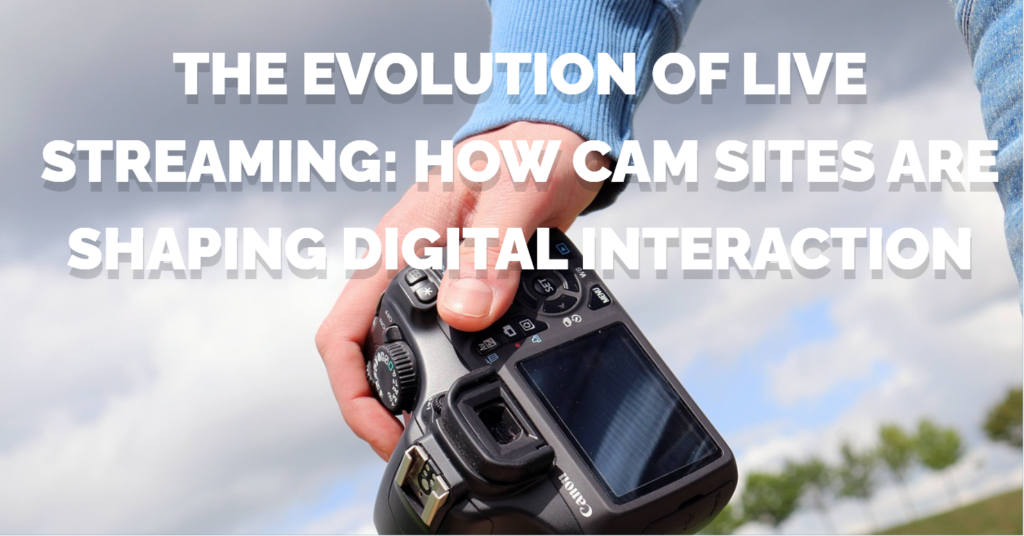The evolution of live streaming has significantly transformed digital interaction, particularly through the emergence and development of cam sites.
These platforms have not only changed the way people consume content but have also created new opportunities for content creators and viewers to connect in real-time. This article delves into the journey of live streaming technology, the rise of cam sites, and their impact on digital communication and entertainment.

The Beginnings of Live Streaming
Live streaming technology emerged as a revolutionary way to broadcast content over the internet in real-time. Initially, it was utilized by traditional media outlets to extend their reach beyond television and radio, allowing for global audiences to tune into live broadcasts via the internet. The technology was complex and costly, limiting its accessibility to larger organizations with the necessary resources. However, as internet speeds increased and streaming technology advanced, live streaming became more accessible to a broader audience.
The early 2000s saw the advent of platforms that democratized live streaming, making it possible for individuals to broadcast their content. These platforms provided the tools needed for creators to share live video content with viewers worldwide, marking the beginning of a significant shift in digital interaction. This period laid the groundwork for the diversity of live streaming applications we see today, from gaming and education to live events and personal vlogs.
Rise of Cam Sites
Cam sites, a subset of live streaming platforms, began to gain prominence by offering a unique interactive experience.
These platforms specialized in real-time video broadcasting where the audience could interact directly with the performers through chat and other engagement features. Unlike traditional live streaming services, cam sites focused on personal and intimate experiences, catering to a wide range of interests and communities. This personalization and interactivity were key to their rapid growth.
The rise of cam sites can be attributed to several factors:
- Technological advancements: Improved video streaming quality and internet speeds made live interactions smoother and more engaging.
- Increased accessibility: The barriers to entry for both creators and viewers decreased, making it easier for anyone to participate.
- Shift in consumer behavior: There was a growing desire for more authentic and interactive forms of online entertainment, moving away from passive consumption.
Impact on Digital Interaction
Cam sites have profoundly impacted digital interaction, reshaping how people connect, share, and experience content online. They have introduced a new level of interactivity, where viewers are not just passive consumers but active participants in the content creation process. This two-way communication has fostered a sense of community and belonging among users, which is often lacking in traditional media.
Moreover, cam sites have pioneered the monetization of live streaming, introducing innovative ways for creators to earn revenue through tips, private shows, and subscription models. This has empowered individuals to build careers around their live streaming activities, contributing to the gig economy and offering a new avenue for entrepreneurship in the digital age.
Challenges and Considerations
Despite their numerous benefits, cam sites for chatting face several challenges, including:
- Privacy and safety concerns: The personal nature of live streaming can expose creators to risks, necessitating robust privacy controls and safety measures.
- Content moderation: Balancing freedom of expression with the prevention of harmful content is a complex issue that requires continuous effort and innovation.
- Market saturation: As more individuals and platforms enter the space, standing out and attracting a dedicated audience becomes increasingly difficult.
Conclusion
The evolution of live streaming, highlighted by the rise of cam sites, has significantly influenced digital interaction.
It has transformed passive viewers into active participants, created new opportunities for content creators, and introduced challenges that continue to shape the industry.
As technology advances and user behaviors evolve, live streaming and cam sites will undoubtedly continue to play a pivotal role in the digital landscape, pushing the boundaries of how we connect and interact online. The future of live streaming promises even greater interactivity, personalization, and community building, further enriching the digital experience for users worldwide.